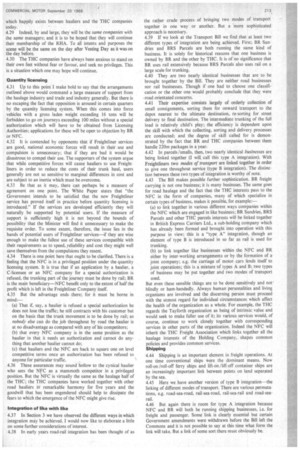Integration of like with like 4.37 In Section 3 we
Page 217

If you've noticed an error in this article please click here to report it so we can fix it.
have observed the different ways in which integration may be achieved. I would now like to elaborate a little on some further considerations of interest.
4.38 In early years road-rail integration has been thought of as the rather crude process of bringing two modes of transport together in one way or another. But a 'more sophisticated approach is necessary.
4.39 If we look at the Transport Bill we find that at least two different types of integration are being achieved. First; BR Sun dries and BRS Parcels are both running the same kind of business. It is solely for historical reasons that one business is owned by BR and the other by THC. It is of no significance that BR uses rail extensively because BRS Parcels also uses rail on a large scale for trunking.
4.40 They are two nearly identical businesses that are to be brought together by the Bill. They are neither road businesses nor rail businesses. Though if one had to choose one classification or the other one would probably conclude that they were .road orientated concerns.
4.41 Their expertise consists largely of orderly collection of small consignments, sorting them for onward transport to the depot nearest to the ultimate destination, re-sorting for street delivery to final destination. The intermediate trunking of the full load is relatively child's play; the efficiency is dependent upon the skill with which the collecting, sorting and delivery processes arc conducted; and the degree of skill called for is demonstrated by the fact that BR and THC companies between them handle 220m packages in a year.
4.42 In parcels/smalls. then, two nearly identical businesses are being linked together (I will, call this type A integration). With Freightliners two modes of transport are linked together in order to give one throughout service (type B integration). The distinction between these two types of integration is worthy of note.
4.43 The Bill makes possible further sophistication. BR freight carrying is not one business; it is many businsses. The same goes
for road haulage and the fact that the THC interests pass to the NFC in the form of companies, many of which specialize in certain types of business, makes it possible, for example:—
(a) to link together in various different ways companies within the NFC which are engaged in like business; BR Sundries, BRS Parcels and other THC parcels interests will be linked together in British Express Carriers Ltd., a sub-holding company which has already been formed and brought into operation with this purpose in view; this is a "type A" integration, though an element of type B is introduced in so far as rail is used for trunking.
(b) to link together like businesses within the NFC and BR either by inter-working arrangements or by the formation of ajoint company; e.g. the .carriage of motor cars lends itself to joint operations; this is a mixture of types A and B; two types of business may be put together and two modes of transport used.
But even these sensible things are to be done sensitively and not.
blindly or ham-handedly. Always human personalities and living organisms are involved and the discerning person must proceed with the utmost regard for individual circumstances which affect the health of the organization as a whole. For example, the THC regards the Tayforth organization as being of intrinsic value and would seek to make fuller use of it; its various services would, of course, continue to work closely together with corresponding services in other parts of the organization. Indeed the NFC will inherit the THC Freight Association which links together all the haulage interests of the Holding Company, shapes common policies and provides common services.
Shipping 4.44 Shipping is an important element in freight operations. At one time conventional ships Were the dominant means. Now roll-on /roll-off ferry ships and lift-on/lift-off container ships are an increasingly important link between points on land separated by the sea.
4.45 Here we have another version of type B integration—the linking of different modes of transport. There are various permutations. e.g. road-sea-road, rail-sea-road, rail-sea-rail and road-searail.
4.46 But again there is room for type A integration because NFC and BR will both be running shipping businesses, i.e. for
freight and passenger. Some link is clearly essential but certain Government amendments were withdrawn before the Bill left the Commons and it is not possible to say at this time what form the link will take. But a link of some sort there must obviously be.


















































































































































































































































































































































































